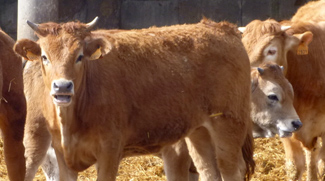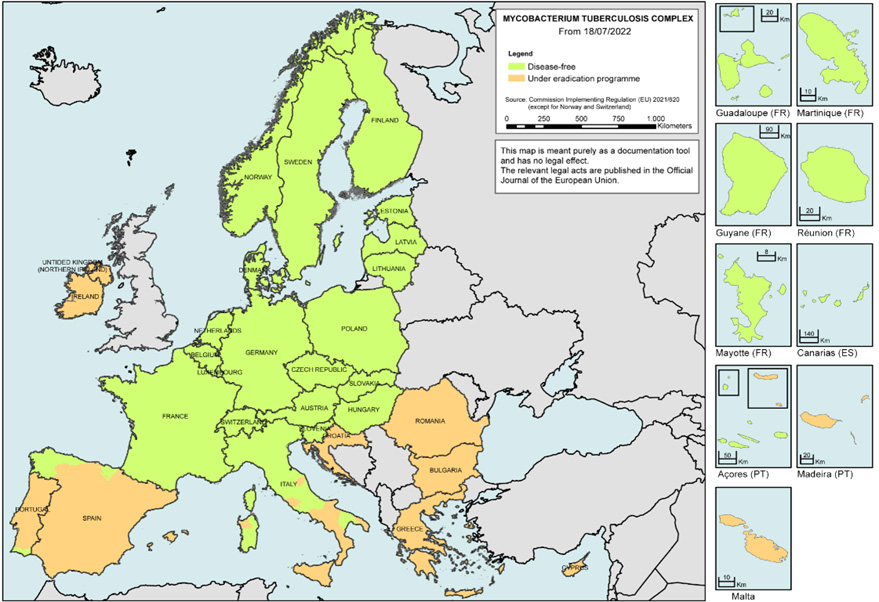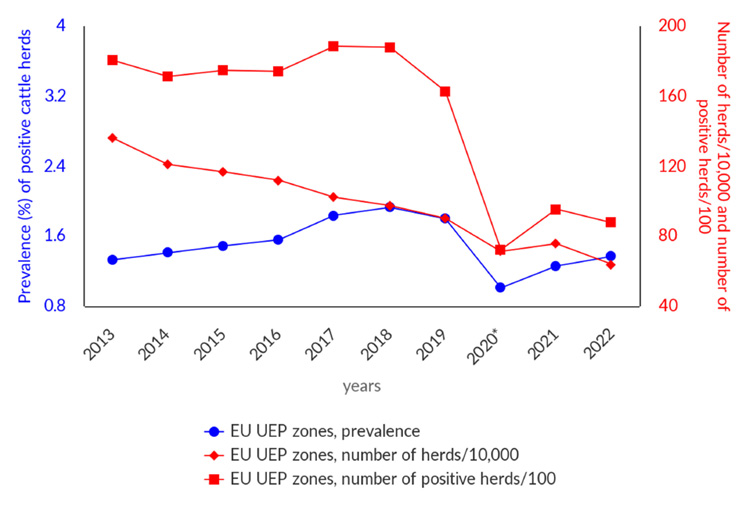Tuberculosis in bovine animals eradication in Europe

According to the Commission Implementing Regulation (EU) 2018/1882, infection with Mycobacterium tuberculosis complex (M. bovis, M. caprae, M. tuberculosis) in bovine animals (Bison spp., Bos spp., Bubalus spp.) is listed as category B disease, therefore it must be controlled in all Member States with the goal of eradicating it throughout the Union, as referred to in Article 9(1)(b) of Regulation (EU) 2016/429. This new regulatory framework for bovine tuberculosis has changed substantially in the EU since 2021 and nowadays, tuberculosis is currently considered a disease to be controlled in all MSs with the goal of eradicating the disease in bovine animals throughout the EU, while being kept under surveillance in other mammals. All MSs must have a surveillance or a control-and-eradication programme approved by the European Commission.
Eradication of TB in bovine animals has been an important issue since the beginning of the European Economic Community (EEC), and current EU policies on the eradication of the disease are best understood after considering the progressive development of relevant Community legislation [1].
The EU policy on the eradication of TB in bovine animals has been based on two main principles:(1) the Member States are primarily responsible for the eradication of TB in bovine animals and may receive community financial support for the eradication program and (2) eradication of TB in bovine animals the EU must be a financial target and the Member States must consider eradication as the defined aim [1].
The scientific report of EFSA and ECDC titled "The European Union One Health 2022 Zoonoses Report" [2] reported a valuable overview of the TB infection in bovine animals in Europe. The country status of freedom from bovine TB in 2022 is presented in Figure 1. Seventeen Member States (MS) had disease-free status from MTBC during 2022. Of the remaining 10 MSs and the United Kingdom (Northern Ireland), three MSs had disease-free zones or provinces (Italy, Portugal and Spain). Seven MSs had no zones with disease-free status regarding MTBC. Norway, Switzerland and Liechtenstein had disease-free status, in accordance with EU legislation, and in Iceland the last outbreak of TB in bovine animals was reported in 1959.

Figure 1. Status of countries for infection with Mycobacterium tuberculosis complex (M. bovis, M. caprae and M. tuberculosis) in the bovine animal population, EU MSs and non-MSs, 2022 (EFSA, 2023) [2].
During 2022, the overall EU prevalence of cattle herds infected with MTBC was very low (0.61%, 9845 infected herds), but slightly higher than that reported in 2021 (0.54%, 9384 infected herds). The zones with non-disease-free status, belonging to 20 MSs, account for 60.4% of the whole EU cattle herd population. Infection is rare in these zones, where only 149 infected herds (0.015%) have been reported. In zones under an eradication programme (i.e. UEP zones), the overall prevalence increased slightly from 1.3% in 2021 to 1.5% in 2022. In the last 10 years (2013-2022), the prevalence of bovine tuberculosis in UEP zones has shown different trends (Figure 2). The significant decrease in 2020 is due to the withdrawal of the United Kingdom from the EU and to the absence of data from Bulgaria in that year. The increase in the number of cattle herds from 2021 onwards can be mainly attributed to the data provided by Bulgaria after the 2020 hiatus and by the United Kingdom (Northern Ireland), in accordance with the agreement on the withdrawal of the United Kingdom from the EU, and in particular with the Protocol on Ireland/Northern Ireland. Prevalence varied widely among MSs with non-disease-free status: Ireland (4.6%) and Spain (2.5%) were the only MSs that reported prevalence higher than 1%; no infected herds were reported by Malta or Cyprus. Most MSs reported MTBC infections without specifying the species involved, although infection with M. bovis and M. caprae was specifically detected in 7 and 3 MSs, respectively. M. tuberculosis in cattle was not reported.

Figure 2. Prevalence of cattle herds positive for bovine tuberculosis in zones under an eradication programme (UEP), EU, 2013–2022. *In contrast to years 2012–2019, year 2020 does not include the United Kingdom data. Since 1 February 2020, the United Kingdom has withdrawn from the EU and has become a third country. No data were reported from Bulgaria (EFSA, 2023)[2]
The Commission implementing regulation (EU) 2021/620 lays down rules for the listed diseases referred in Regulation (EU) 2016/429 of animals, as regards the disease-free and non-vaccination status of certain Member States or zones or compartments thereof, and the approval of eradication programmes for those listed diseases. The Annex II of this regulation list: i) the Member States or zones thereof with disease-free status from infection with Mycobacterium tuberculosis complex (Mycobacterium bovis, M. caprae and M. tuberculosis) (MTBC); and ii) the Member States or zones thereof with an approved compulsory eradication programme for infection with MTBC. In table 1 there is a summary of the information included in Annex II (consolidated text 27/11/2023).
Table 1. Member States or zones thereof with disease-free status or approved eradication programme from infection with MTBC (Commission implementing regulation 2021/620).
Member State |
Disease-free status |
Approved eradication programme |
Austria, Belgium, Czechia, Denmark, Estonia, Finland, France, Germany, Hungary, Latvia, Lithuania, Luxembourg, Netherlands, Poland, Slovakia, Slovenia, Sweden |
Whole territory |
|
Bulgaria, Croatia, Cyprus, Greece, Ireland, Malta, Romania |
|
Whole territory |
Italy |
RR Abruzzo; R Basilicata: Provincia di Matera; R. Calabria: Provincia di Catanzaro; R. Campania: Provincia di Napoli; R Emilia-Romagna; R Friuli Venezia Giulia; R Lazio: Provincia di Frosinone, Latina, Rieti, Viterbo; R Liguria; R Lombardia; R Marche: Provincia di Ancona, Ascoli Piceno, Fermo, Pesaro-Urbino; R Molise; R Piemonte; R Puglia: Provincia di Bari, arletta-Andria- Trani, Brindisi, Lecce, Taranto; R Sardegna: Citta metropolitana di Cagliari, Provincia di Medio Campidano, Nord Est Sardegna, Nuoro, Ogliastra, Oristano, Sulcis Iglesiente; R Toscana; R Trentino – Alto Adige; R Umbria; R Valle d’Aosta; R Veneto |
R Basilicata: Provincia di Potenza; R Calabria: Provincia di Cosenza, Crotone, Reggio Calabria, Vibo Valentia; R Campania: Provincia d’Avellino, Caserta, Benevento, Salerno; R Lazio: Provincia di Roma; R Marche: Provincia di Macerata; R Puglia: Foggia; R Sardegna: Città metropolitana di Sassari; R Sicilia |
Portugal |
R Algarve: all distritos; Autónoma dos Açores except Ilha de São Miguel |
R Autónoma dos Açores: Ilha de São Miguel; R Autónoma da Madeira; Distritos Aveiro, Beja, Braga, Bragança, Castelo Branco, Coimbra, Evora, Guarda, Leiria, Lisboa, Portalegre, Porto, Santarem, Setubal, Viana do Castelo, Vila Real, Viseu |
Spain |
CA de Canarias; CA de Castilla y León: Province of Burgos, León, Valladolid; CA de Cataluña; CA de Galicia; CA de Islas Baleares; CA de Murcia; CA del País Vasco; CA del Principado de Asturias |
CA de Andalucía; CA de Aragón; CA de Cantabria; CA de Castilla-La Mancha; CA de Castilla y León: Province of Ávila, Palencia, Salamanca, Segovia, Soria, Zamora; CA de Extremadura; CA de La Rioja; CA de Madrid; CA de Navarra; CA de Valencia |
United Kingdom (Northern Ireland) |
|
Northern Ireland |
R. Regione (Italy) or Região (Portugal); D. Distritos; CA. Comunidad Autónoma. |
||
References
- Reviriego Gordejo, F.J., Vermeersch, J.P. 2006. Towards eradication of bovine tuberculosis in the European Union. Vet. Microbiol, 112:101-109.
- EFSA, 2023. The European Union One Health 2022 Zoonoses Report. EFSA Journal, 21(12):e8442.
